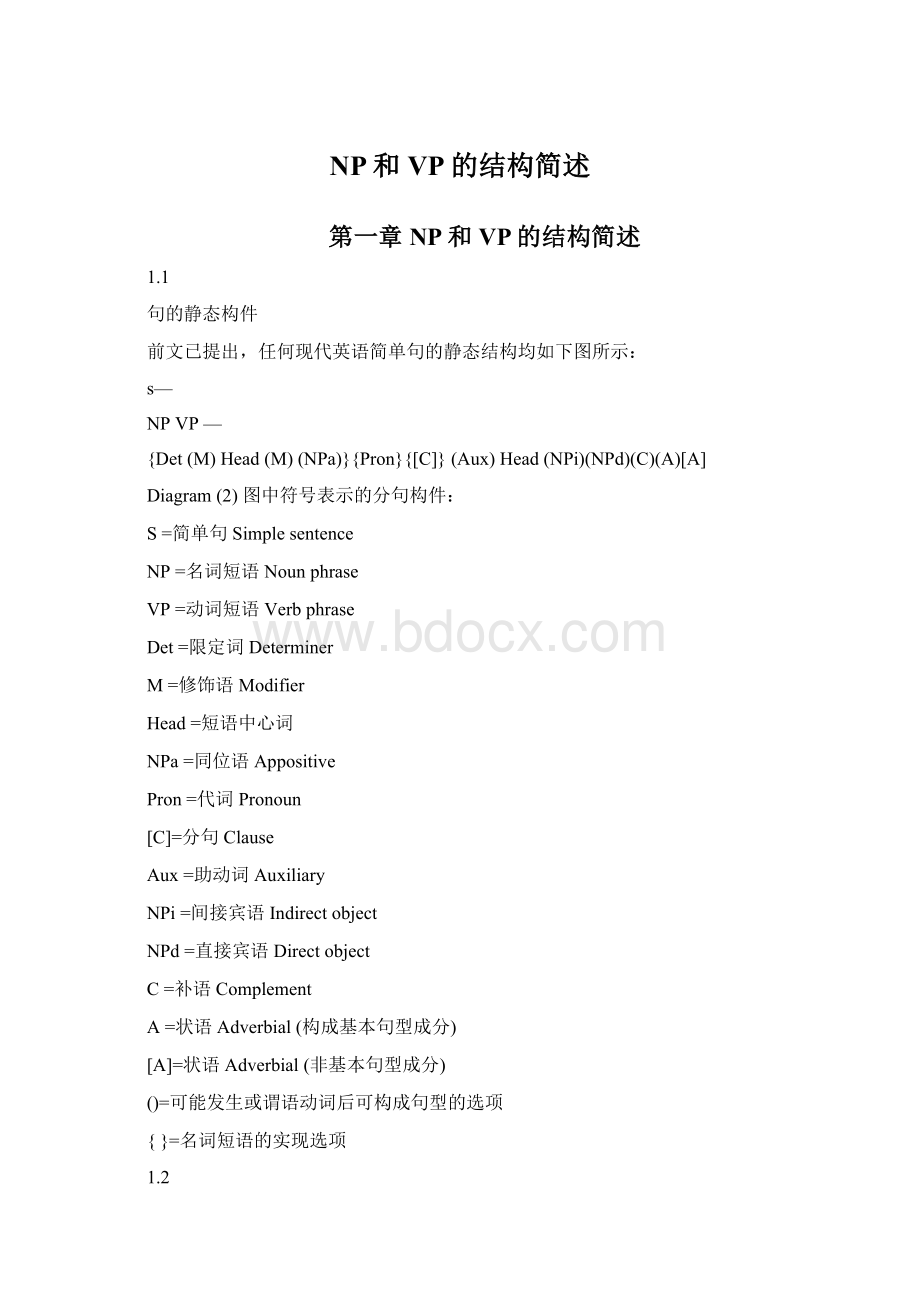NP和VP的结构简述.docx
《NP和VP的结构简述.docx》由会员分享,可在线阅读,更多相关《NP和VP的结构简述.docx(13页珍藏版)》请在冰豆网上搜索。

NP和VP的结构简述
第一章NP和VP的结构简述
1.1
句的静态构件
前文已提出,任何现代英语简单句的静态结构均如下图所示:
s—
NPVP—
{Det(M)Head(M)(NPa)}{Pron}{[C]}(Aux)Head(NPi)(NPd)(C)(A)[A]
Diagram
(2)图中符号表示的分句构件:
S=简单句Simplesentence
NP=名词短语Nounphrase
VP=动词短语Verbphrase
Det=限定词Determiner
M=修饰语Modifier
Head=短语中心词
NPa=同位语Appositive
Pron=代词Pronoun
[C]=分句Clause
Aux=助动词Auxiliary
NPi=间接宾语Indirectobject
NPd=直接宾语Directobject
C=补语Complement
A=状语Adverbial(构成基本句型成分)
[A]=状语Adverbial(非基本句型成分)
()=可能发生或谓语动词后可构成句型的选项
{}=名词短语的实现选项
1.2
NP的结构成分简述及所在章节提示
NP—
{Det(M)Head(M)(NPa)}{Pron}{[C]}
Diagram(3)
图(3)表示凡名词短语就有也只有三种实现:
NP=Det(M)Head(M)(NPa)
=Pron
=[C]
1.2.1
名词短语的第一实现:
NP=Det(M)Head(M)(NPa)
Det
这一实现是最常见的名词短语,此时限定词Det是不可或缺的短语构件:
agirl
oneroom
myfamily
thisquestion
Tom'problemnocityetc.
限定词的成员主要源于传统词类中的冠词、部分代词、数词、量词和名词属格。
限定词的语法属性,限定词与名词中心词搭配情形以及限定词自身的相互关系共同构成第二章的语法内容;核心限定词冠词的讨论见第三章。
(M)
名词短语中心词的修饰语(M)分别位于名词中心词前后,又有前位修饰语和后位修饰语之称。
修饰语理论上无限:
不同于限定词,修饰语的出现与否和多寡无碍短语的句法地位:
atable是完美无缺的名词短语,然而人们不能接受delicatewell-coloredsmalloakblethatisreallyadmirable这样没有限定词的情形!
第五章对修饰语进行大致分析,第十三章及第十九章也会继续这一话题。
Head
名词短语中心词Head为名词。
现代英语留存着屈折词素-s和-',因此可确认的名词语法范畴有二:
数theNumber和格theCase;人们大都不赞同性theGender作为名词范畴的说法,但我们仍会对其语法特征和相关语用表示关注。
数的系统语法知识围绕可变名词和不可变名词展开,内容依序包括:
规则可
变,不规则本族语,外来语;单数不变名词,复数不变名词和单复数均可的不变名词。
格的系统语法知识表现于属格Genitivecase的形态:
-'属格,of-属格,双重属格Doublegenitive和独立属格Independentgenitive属格所表达短语成分间的各种意义关系:
所属,类别,描写,出处,主谓,动宾,同位等。
现代英语中还有些许标识性的屈折词素如-ess但只是局部现象而无规律意
义。
不过由于代词的缘故,英语名词能分为五类:
阳性如father,阴性如queen,
中性如house双性如teacher以及通性如baby。
各范畴的具体内容见第四章。
(NPa)
同位语(NPa)和修饰语一样,是名词短语可能发生的构件。
同位语亦为名词短语或名词性分句:
MyfriendAnnawasherelastnight.
(NPa)
Mr.Parsons,thepresidentofthecompangaveapressconferenceafter
(NPa)
sswornnevertodepart
theboardmeeting.
Theprettygirl,agirlsodeartohimthathe(NPa)
from,isnoneotherthanMr.Brown'sdaughter.ThequestionwhethertoconfessornOtoubledthegirl.
(NPa)
Theexplanationthathecouldnotbeseenbyanybodyasdisappointing.
(NPa)
同位语的讨论见第二十二章
1.2.2
名词短语的第二实现:
Pron
代词Pron为名词短语的第二实现:
Theysaythereisgoingtobeastorm.
NP
Sureenough,l'llinformhimaboutit.
NPNPNP
英语有八类代词:
人称代词PersonalPronoun,物主代词PossessivePronoun,指示代词DemonstrativePronoun疑问代词InterrogativePronoun,不定代词IndefinitePronoun,相互代词ReciprocalPronoun反身代词ReflexivePronoun和关系代词RelativePronour。
代词的主要内容将在第五章讨论。
1.2.3
名词短语的第三实现:
[C]
分句[C]为名词短语的第三实现:
Thathewillneveradmititeavesnoroomfordoubt.
NP
Itremainstobeknownwhenhewillpayusavisit
NP
Thisiswhatshehasdescribed
NP
Toliveornottoliveisaquestion.
NPNP
Takingnoteswhilereadingisagoodhabit.
NPNP
分句实现名词短语是句法内容,第十七章将讨论这一实现的全部情形。
1.3
VP的结构成分简述及所在章节提示
VP一
(Aux)Head(NPi)(NPd)(C)(A)[A]
Diagram(4)
1.3.1
(Aux)
助动词(Aux)属于功能词,封闭词类。
无助动词的动词短语为简单动词短语SimpleVP,含助动词的动词短语为复杂动词短语ComplexVP。
助动词大致分为三类:
基本助动词Primaryauxiliary;半助动词Semi-auxiliary和情态助动词Modalauxiliary。
基本助动词do完成否定、疑问、强调、倒装和替代的句式转换:
Hedidn'tdoit.
Didhedoit?
Hediddoit.
Sodidhisbrother.
Yes,hedid
基本助动词have实现完成体:
Hehasreadthearticleseveraltimes.
基本助动词be实现进行体和被动态:
Heissleepinghismoment.
Hewasquestionediboutthematter.
半助动词get等实现被动态或表达情态:
Hegotbeaten.
Heseemstdoesorrowful.
Hehappenedtdbepresentatthemeeting.
半助动词由于助动功能残缺而得名:
Hedidn'tgetbeaten.
*Hegotnotbeaten.
Didhegetbeaten.
*Gothebeaten?
助动词的合作依序为“情态一完成一被动一进行”
Hemayhavebeenbeinguestioned.
情态助动词是现代英语语法重大难点之一,第十章将专章讨论。
1.3.2
Head
动词短语中心词Head为实意动词,属开放词类。
动词的语法范畴有四:
时态theTense体theAspec,语态theVoice和语气theMood。
时态表示动词和时间的关系,英语动词有现在时thePresentTens和过去时thePastTense两个时态;体是表示行为状态的动词语法范畴,英语由助动词和分词共同实现进行体theProgressive和完成体thePerfective的意义表达;英语有主动语态theActiveVoice与被动语态thePassiveVoiced分,指示主语和谓语动词之间施动或受动的关系,主要语法内容包括被动语态的形态,语境和语态实现条件;英语有丰富的语气表达方式,也有两型虚拟动词形式;现代英语只有两个时态但具备丰富的将来时间表达方式。
这一切将依序分别在第六至第九章中讨
论。
从形态上认识,英语动词分为单词动词如find,双词动词如lookfor,多词动词如takecareof规则动词如work,不规则动词如set=
双词动词又分介词动词Prepositionalverb如dependor和短语动词Phrasalverb如giveup其区分意义可见于以下各例的比较:
Hehasgiventheideaup.
*Thegirltotallydependshergrandfatheron.
Hehasgivenitup
Thegirldependstotallyonhim.
*Hehasgivenupit
Itisonhergrandfatheithatthegirltotallydepends
*Itisuptheideathathehasgiven.
Thelittlegirldependstotallyonhergrandfather,notonhergrandmother.*Hehasgivenupsmoking,notupdrinking.
从语义上认识,英语动词主要分静态动词Stativeverb如belongto动态动词Dynamicverb女口cry(,短暂性动词Momentaryverb女口hit,持续性动词Durativeverb女口stand(,感官动词Perceptiveverb女口see使役动词Causativeverb女口make(18.2,1)。
从句法上认识,英语动词分及物动词Transitiveverb,如release不及物动词Intransitiveverb如live和系动词Linkverb女口be和反身动词Reflexiveverb如avail(5.23a)。
及物动词分单及物Mono-transitive如support双及物Di-transitive如show和复杂及物Complex-transitive女口name三类。
它们的句法特征决定(NPi)(NPd)(C)(A)的选项形成现代英语的全部基本句型:
NP+V(intransitive)
Someonewaslaughing.
NP+V+NP(mono-transitive)
Mymotherenjoysparties.
NP+V+NP+NP(di-transitive)
Marygavethevisitoraglassofmilk.
NP+V+NP+C(complex-transitive)
Mostpeopleconsiderthesebooksratherexpensive.
NP+V+(C)(linkverb)
Thecountrybecamecompletelyindependent.
NP+V+(A)(intransitive)
Shelivednexttoourhouseatthattime.
NP+V+NP+(A)
Shealwaystreatsmekindly.(transitive)
1.3.3
(NPi)(NPd)(C)(A)[A]
(NPi)间接宾语
间接宾语通常为人称代词或名词,位于直接宾语前和双及物动词构成V(NPi)
(NPd)基本句型;直接宾语是代词时,间接宾语在英国英语(BrE)中可见在直接宾语之后:
Giveitme
间接宾语可转换成介词短语:
Shesentmeacard.
Shesentcardtome
SheleftTomamessage.
SheleftamessageorTom
to和for为这种现象最常见的介词,少数其它介词也有此功能:
Sheaskedmeafavor.
Sheaskedafavoofme
Ibearhimnogrudge.
Ibearnogrudgeagainsthim
Heplayedmeanawfultrick.
Heplayedanawfultrickonme
和其它NP不同,(NPi)不可扩大为分句。
(NPd)直接宾语
直接宾语和单及物动词,双及物动词以及复杂及物动词构成四种基本句型:
BillopenedtheletterV(NPd)
I'VbundyouaniceplaceV(NPi)(NPd)
HepainedthewallblueV(NPd)(C)
JohnputherpurseontheTVseV(NPd)(A)双宾结构中直接宾语可能由介词引导:
Theyrobbedhimofeverything
Itwillcureyouofyourdisease直接宾语能和不及物动词合作,称同源宾语Cognateobject
Idreamedastrangedream
Thenhesmiledthemockingsmil签heknewsowell.
TheCourtneynoddedandsmiledafriendlygreeting
HethankedGodforbringingthemtogether,andaskedthattheybeallowedtolivefruitfulandusefullivestogether
Whywasshethinkingsuchthoughts
Instead,shesaid,“Whynot?
”ShesmiledaninvitationandsavoredArista'ssurprise.
Simonechosethattimewhenbothmamaandherenceintesister-in-lawweresleepingthehottesthourofthedayawaytoexploreseveralroomsthatwereseldomused.
Hebreathedadeepbreath
Thegirldiedadreadfuldeath
A:
Haveyouheardhoundsbayinginthenight?
B:
Ithinkyouweredreamingthem
(NPd)的分句扩大见第十七章。
(C):
补语
补语又分主语补语(Cs)和宾语补语(Co),分别与系动词和复杂及物动词构成V(Cs)和V(NPd)(Co)基本句型;补语由形容词(短语),名词,副词(短语),介词短语和分句实现:
She'sgatigry.
Hegothisshoesandsockwet
Bobisaqualifiedengineer
InamedthedogTressy
Timeisup.
Theangryaudieneeshoutedthespeakdown.
Marywasinthegarden
Finallyshetalkedherhusbandntobuyinganewcarforhe
Myideaisthatwehavetoaccepthisoffer
Whatsheenjoysbestis*eadingHemingway'sworks
Hissuggestionistogoswimmingthisafternoon
Weheardwaterflowingundertheground
Wecan'tletthemattersthere
Shehadhermoneystolen
补语的分句扩大见第十八章。
(A):
构成句型的状语
(A)与不及物动词和复杂及物动词分别构成V(A)和V(NP)(A)基本句型,:
HelivesinBeijing.
*Helives.
Don'ttaketooseriously
=/=Don'ttakeit.
(A)常为时间,地点和方式状语:
Helivedlongago
Sheplacedthebookcarefullyintothedrawer
ShetreateduSikeamother
Tomstoodwhereshewasnotabletoseehim
[A]:
不构成句型的状语
[A]由词,短语和分句实现,其存在与否不改变句型:
Itisfinetoday
Itisfine.
Wewenttothestationinagreathurry
Wewenttothestation.
Whatwouldyoudoifyouweretheboy
Whatwouldyoudo?
[A]在句中的位移性很强:
Thepupilswerebehavingwellwhiletheteacherwaswiththemnaturally.Naturally,thepupilswerebehavingwellwhiletheteacherwaswiththem.
Thepupils,naturally,werebehavingwellwhiletheteacherwaswiththem.
[A]的句法功能和语义分类以及分句扩大详见第十一,第十二章和第二十三早。
Exercises:
1.Writesevensentencesofyourowntoshowyouarefamiliarwiththeseven
sentencepatterns(写出各句型的句子).
2.Arethefollowingtwosentencesofthesamesentencepattern?
Comeupwithyourreasoning(以下二句句型是否同一?
为什么?
)
BillwillmakeMaryagoodwife.
BillwillmakeMaryagoodhusband.
3.Doyouthinktherecanbemoresub-classificationsoftheheadofVP?
What
aretheythen(动词短语中心词还可能有次分类吗?
)?
4.Tellthegrammaticalfunctionoftheitalicizedpartsofthesentencesbelo^说出以下句子中斜体部分的语法功能):
⑴Hefailedtopasstheexaminationnotbecausehewaslazybutbecausethequestionsweretoodifficult
(2)Thecarhittheboyrunningacrossthestrete
(3)EighteenyearslaterDrSmithwasreleased?
changedman
(4)Theyelectedherchairmanoftheclass
(5)Thisiswhathetoldusatthemeeting
(6)Heaskedmewhetheritwouldrain
(7)Myoriginalquestion,whyhedidnotgototheteacherforadvicphasnotbeenanswered.
(8)Don'tputoffuntiltomorrowwhatyoucandotoday
(9)Itisessentialthatyouhavesomeoneasyourcompany
(10)Whatsnowconcea|Shesunreveals
(11)Couldyoudomeafavor?
(12)Youngasshe,shegirlcanbetrusted.
(13)Whodoyouthinkyouare?
(14)Haven'ttheyfoundioutyet?
(15)I'ninterribleneedofsomemoney
(16)Earlyreportssaidallthreeplanesusedintheattackswerehijacked,oneofthemfromBostonandonefromWashington
(17)ItishardtoshowscientificallythatTVandfilmsinflueneethewaypeoplethinkandact
(18)IntheairwaragainstSaddam,targetsarepickedtominimizewhatiscalled:
“collateraldamage”
(19)Itwashere,inSpringfield,wherenorth,south,east,andwestcometogetherthatIwasremindedoftheessentialdecencyoftheA